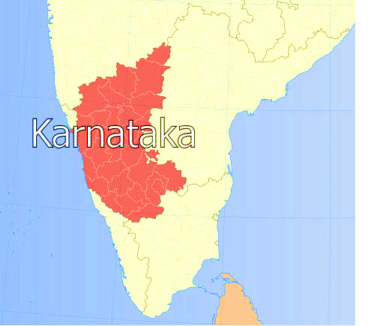
(Bildquelle: PlaneMad/Wikipedia. -- CC-by-sa)

(Bildquelle: PlaneMad/Wikipedia. -- CC-by-sa)
Zitierweise / cite as:
Hodson, Thomas: An elementary grammar of the Kannada, or Canarese language. -- 27. Syntax of Relative Participles (§§ 232 - 238.). -- Fassung vom 2011-08-26. -- URL: http://www.payer.de/hodson/hodson27.htm
First published as: Hodson, Thomas: An elementary grammar of the Kannada, or Canarese language ; in which every word used in the examples is translated, and the pronunciation is given in English characters. -- 2. ed. -- Bangalore : Wesleyan Mission Press, 1864. -- 128 p. ; 23 cm.
First time published here: 2011-08-26
Revisions:
©opyright: Public domain
This text is part of the section Sanskrit und Indien of Tüpfli's Global Village Library
If you don't get the diacritics displayed, install a Unicode font like Tahoma.
232. Relative participles admit of a nominative case before them, and perform the office of verb and relative pronoun to nouns and pronouns following them; as,
233. These relative participles govern a preceding noun like a verb; as,
234. The passive participle requires the instrumental case of the agent or instrument; as,
235. The participles of an intransitive verb are both preceded and followed by nominatives; as.
236. The relation expressed by the relative participle must often, according to the sense of the verb, be rendered in English by "in which," "from which," "with whom," &c. &c.; as,
237. Sometimes the relative participle has both a preceding and following nominative, and governs an accusative or other case.
In such sentences this order is followed; viz.
1st the agent in the nominative case
2nd the object generally in the accusative
3rd the relative participle
4th the instrument, &c. in the nominative
as,
ಹುಲಿಯು ಎತ್ತನ್ನು ಕಚ್ಚಿದ ಹಲ್ಲು huliyu ettannu kaccida hallu, The tooth with which the tiger bit the ox.
ತಂದೆ ನನಗೆ ಕೊಟ್ಟ ಹಣ taṃde nanage koṭṭa haṇa, The money which my father gave to me
ನೀನು ಅವನನ್ನು ಕರೆದ ಹೆಸರು nīnu avanannu kareda hesaru, The name by which you called him.
238. Relative participles become nouns by the addition of pronouns, according to the rules of sandhi; as,
| ಹೇಳುವ hēḷuva | who or which says | ಹೇಳುವವನು hēḷuvavanu | he who says |
| ಹೇಳುವವಳು hēḷuvavaḷu | she
who says &c. |
||
| ಹೇಳಿದ hēḷida | who or which said | ಹೇಳಿದವನು hēḷidavanu | he who said |
| ಹೇಳಿದವರು hēḷidavaru | they who said | ||
| ಹೇಳದ hēḷada | who or which did not say | ಹೇಳದವನು hēḷadavanu | he
who did not say &c. &c. |
For the union of ಅದು adu, with the past and negative participles, See §§ 23, 24.
For the union of ರೆ re, ರೂ rū, and ಆಗ್ಯೂ āgyū, with the past participle, and ಹಾಗೆ hāge, with the present participle, See the subjunctive mood.
To 28. Syntax of Infinitive Mood (§§ 239 - 246)